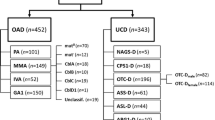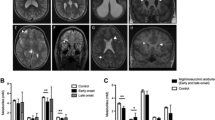Summary
‘Classical organic acidurias’ comprise isovaleric aciduria, propionic aciduria and methylmalonic aciduria. Available data from the literature suggest that the use of ‘new’ therapeutic strategies has improved survival but has not modified neurodevelopment. Progressive neurocognitive deterioration is almost invariably present in propionic and methylmalonic acidurias, while large-scale studies on the long-term outcome of patients with isovaleric aciduria are still lacking. In order to answer to some of the questions suggested by Wilson and Jungner in 1968 about the criteria of disease screening, we compared the natural history of patients with ‘classical’ organic acidurias diagnosed on clinical bases to those diagnosed through neonatal mass screening using tandem mass spectrometry. Decreased early mortality, less severe symptoms at diagnosis, and more favourable short-term neurodevelopmental outcome were recorded in patients identified through expanded newborn screening. The short duration of follow-up so far does not allow us to draw final conclusions about the effects of newborn screening on long-term outcome. The evaluation of the effect of neonatal screening on the detection rate of these three diseases showed that the incidence of isovaleric aciduria was significantly higher in the screening population than in clinically detected cases, with no changes for propionic and methylmalonic acidurias. Further multicentre longitudinal studies are needed to assess the usefulness of expanded newborn screening for ‘classical’ organic acidurias and to better understand the clinical spectrum of these diseases. This paper describes the long-term outcome and the impact of expanded newborn screening on the so-called ‘classical’ organic acidurias (propionic aciduria, methylmalonic aciduria and isovaleric aciduria).
Similar content being viewed by others
References
Applegarth DA, Toone JR, Lowry RB (2000) Incidence of inborn errors of metabolism in British Columbia, 1969–1996. Pediatrics 105: e10.
Baumgarter ER, Viardot C (1995) Long-term follow-up of 77 patients with isolated methylmalonic acidaemia. J Inherit Metab Dis 18: 138–142.
Burlina AB, Dionisi-Vici C, Piovan S, et al (1995) Acute pancreatitis in propionic acidaemia. J Inherit Metab Dis 18: 169–172.
Chakrapani A, Sivakumar P, McKiernan PJ, Leonard JV (2002) Metabolic stroke in methylmalonic acidemia five years after liver transplantation. J Pediatr 140: 261–263.
Deodato F, Rizzo C, Boenzi S, Baiocco F, Sabetta G, Dionisi-Vici C (2002) Successful pregnancy in a woman with muttmethylmalonic acidaemia. J Inherit Metab Dis 25: 133–134.
Deodato F, Boenzi S, Rizzo C, et al (2004) Inborn errors of metabolism: an update on epidemiology and on neonatal-onset hyperammonemia. Acta Paediatr Suppl 93: 18–21.
Dionisi-Vici C, Rizzo C, Burlina AB, et al (2002) Inborn errors of metabolism in the Italian pediatric population: a national retrospective survey. J Pediatr 140: 321–327.
Ensenauer R, Gruenert S, Willard J, et al (2003) Natural history of isovaleric acidemia. J Inherit Metab Dis 26: 38.
Ensenauer R, Vockley J, Willard JM, et al (2004) A common mutation is associated with a mild, potentially asymptomatic phenotype in patients with isovaleric acidemia diagnosed by newborn screening. Am J Hum Genet 75: 1136–1142.
Gebhardt B, Vlaho S, Fischer D, Sewell A, Bohles H (2003) $N$-Carbamylglutamate enhances ammonia detoxification in a patient with decompensated methylmalonic aciduria. Mol Genet Metab 79: 303–304.
Gebhardt B, Dittrich S, Parbel S, Vlaho S, Matsika O, Bohles H (2005) $N$-Carbamylglutamate protects patients with decompensated propionic aciduria from hyperammonaemia. J Inherit Metab Dis 28: 241–244.
Hoffmann GF, von Kries R, Klose D, et al (2004) Frequencies of inherited organic acidurias and disorders of mitochondrial fatty acid transport and oxidation in Germany. Eur J Pediatr 163: 76–80.
Hori D, Hasegawa Y, Kimura M, Yang Y, Verma IC, Yamaguchi S (2005) Clinical onset and prognosis of Asian children with organic acidemias, as detected by analysis of urinary organic acids using GC/MS, instead of mass screening. Brain Dev 27: 39–45.
Kayler LK, Merion RM, Lee S, et al (2002) Long-term survival after liver transplantation in children with metabolic disorders. Pediatr Transplant 6: 295–300.
Klose DA, Kolker S, Heinrich B, et al (2002) Incidence and short-term outcome of children with symptomatic presentation of organic acid and fatty acid oxidation disorders in Germany. Pediatrics 110: 1204–1211.
Knerr I, Weiglel C, Rauh M, et al (2005) Evaluation and follow-up care of children with benign metabolic phenotypes of inborn errors of metabolism, fortuitously detected in newborn screening programs using tandem mass spectrometry. J Inherit Metab Dis 28: 12.
Lehnert W, Sperl W, Suormala T, Baumgartner ER (1994) Propionic acidaemia: clinical, biochemical and therapeutic aspects. Experience in 30 patients. Eur J Pediatr 153(Supplement 1): 68–80.
Leonard JV, Walter JH, McKiernan PJ (2001) The management of organic acidaemias: the role of transplantation. J Inherit Metab Dis 24: 309–311.
Mardach R, Verity MA, Cederbaum SD (2005) Clinical, pathological, and biochemical studies in a patient with propionic acidemia and fatal cardiomyopathy. Mol Genet Metab 85: 286–290.
Massoud AF, Leonard JV (1993) Cardiomyopathy in propionic acidaemia. Eur J Pediatr 152: 441–445.
Morioka D, Takada Y, Kasahara M, et al (2005) Living donor liver transplantation for noncirrhotic inheritable metabolic liver diseases: impact of the use of heterozygous donors. Transplantation 80: 623–628.
Nagarajan S, Enns GM, Millan MT, Winter S, Sarwal MM (2005) Management of methylmalonic acidaemia by combined liver—kidney transplantation. J Inherit Metab Dis 28: 517–524.
Nicolaides P, Leonard J, Surtees R (1998) Neurological outcome of methylmalonic acidaemia. Arch Dis Child 78: 508–512.
North KN, Korson MS, Gopal YR, et al (1995) Neonatal-onset propionic acidemia: neurologic and developmental profiles, and implications for management. J Pediatr 126: 916–922.
Nyhan WL, Gargus JJ, Boyle K, Selby R, Koch R (2002) Progressive neurologic disability in methylmalonic acidemia despite transplantation of the liver. Eur J Pediatr 161: 377–379.
Ogier de Baulny H, Saudubray JM. (2000) Branched-chain organic acidurias. In: Fenrnades J, Saudubray JM, van den Berge G, eds. Inborn Metabolic Diseases. Springer-Verlag, Berlin, 197–212.
Ogier de Baulny H, Benoist JF, Rigal O, Touati G, Rabier D, Saudubray JM (2005) Methylmalonic and propionic acidaemias: management and outcome. J Inherit Metab Dis 28: 415–423.
Picca S, Dionisi-Vici C, Abeni D, et al (2001) Extracorporeal dialysis in neonatal hyperammonemia: modalities and prognostic indicators. Pediatr Nephrol 16: 862–867.
Rousson R, Guibaud P (1984) Long term outcome of organic acidurias: survey of 105 French cases (1967–1983). J Inherit Metab Dis 7(Supplement 1): 10–12.
Sass JO, Hofmann M, Skladal D, Mayatepek E, Schwahn B, Sperl W (2004) Propionic acidemia revisited: a workshop report. Clin Pediatr (Phila) 43: 837–843.
Saudubray JM, Touati G, Delonlay P, et al (1999) Liver transplantation in propionic acidaemia. Eur J Pediatr 158(Supplement 2): 65–69.
Schulze A, Lindner M, Kohlmuller D, Olgemoller K, Mayatepek E, Hoffmann GF (2003) Expanded newborn screening for inborn errors of metabolism by electrospray ionization-tandem mass spectrometry: results, outcome, and implications. Pediatrics 111: 1399–1406.
Surtees RA, Matthews EE, Leonard JV (1992) Neurologic outcome of propionic acidemia. Pediatr Neurol 8: 333–337.
Van Calcar SC, Harding CO, Lyne P, et al (1998) Renal transplantation in a patient with methylmalonic acidaemia. J Inherit Metab Dis 21: 729–737.
van der Meer SB, Poggi F, Spada M, et al (1994) Clinical outcome of long-term management of patients with vitamin B12-unresponsive methylmalonic acidemia. J Pediatr 125: 903–908.
van der Meer SB, Poggi F, Spada M, et al (1996) Clinical outcome and long-term management of 17 patients with propionic acidaemia. Eur J Pediatr 155: 205–210.
van't Hoff W, McKiernan PJ, Surtees RA, Leonard JV (1999) Liver transplantation for methylmalonic acidaemia. Eur J Pediatr 158(Supplement 2): 70–74.
Waisbren SE, Albers S, Amato S, et al (2003) Effect of expanded newborn screening for biochemical genetic disorders on child outcomes and parental stress. JAMA 290: 2564–2572.
Wilcken B, Wiley V, Hammond J, Carpenter K (2003) Screening newborns for inborn errors of metabolism by tandem mass spectrometry. N Engl J Med 348: 2304–2312.
Wilson JMG, Jungner G (1968) Principles and practice of screening for disease. Public Health Papers WHO 34: 26–39.
Author information
Authors and Affiliations
Corresponding author
Additional information
Communicating editor: Jean-Marie Saudubray
Competing interests: None declared
Rights and permissions
About this article
Cite this article
Dionisi-Vici, C., Deodato, F., Röschinger, W. et al. ‘Classical’ organic acidurias, propionic aciduria, methylmalonic aciduria and isovaleric aciduria: Long-term outcome and effects of expanded newborn screening using tandem mass spectrometry. J Inherit Metab Dis 29, 383–389 (2006). https://doi.org/10.1007/s10545-006-0278-z
Received:
Accepted:
Issue Date:
DOI: https://doi.org/10.1007/s10545-006-0278-z




